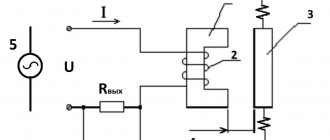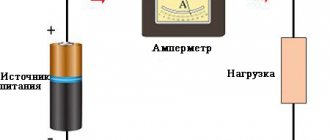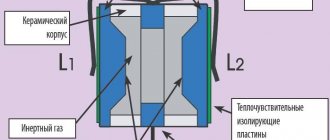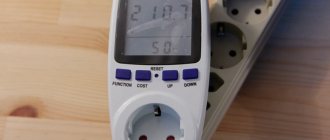Instruments for measuring current strength
An ammeter is a device for determining the strength of both direct and alternating current in an electrical circuit.
Based on the purpose of the devices for certain current values, ammeters, milliammeters and microammeters are distinguished. Depending on the operating principle and application features, the following types of ammeters are distinguished. Let us consider in detail their specifics and main parameters:
- analog ammeters, which have a magnetoelectric system. They are made on the basis of a coil of thin wire rotating between magnetic poles. As current passes through the coil, it is fixed under the influence of a torque, the value of which is proportional to the magnitude of the current. The device has a special spring that prevents the coil from rotating, and the elasticity of the spring is proportional to the angle of rotation. When balance is established, these moments are equalized, and the arrow is set to a value proportional to the current value at the moment.
The advantage of analog instruments is that there is no need to provide independent power to determine the result, since the measurement process uses power directly from the electrical circuit that is being measured. Increased sensitivity is also a plus. Among the disadvantages is the long time it takes to fix the arrow in a stable position.
- electromagnetic - designed in the form of mechanisms with a fixed coil through which current passes. There are also several cores on the axis. The devices are designed to be fixed with DC measuring probes. The elements of the devices are a meter and a scale with marked divisions.
The undoubted advantages of this type of device are the ability to measure AC and DC current, as well as ease of use. The disadvantages are low sensitivity, as a result of which they are used in areas where there is no need for ultra-precise indicators;
- electrodynamic devices - their operating principle is based on the interaction of magnetic fields of voltage flowing through fixed and rotating coils. The devices use simultaneous and alternating activation of coils; the device can be used at elevated frequencies of up to 200 Hz. The devices are sensitive to extraneous magnetic fields, so measurements are not highly accurate, and it is recommended to take measurements away from other sources of magnetic field;
- ferrodynamic - are one of the most modern and used types of ammeters, since they practically do not react to other magnetic fields and are durable. The elements of the device are a closed magnetic conductor made of ferromagnetic material, a core in the base and a fixed coil. The main area of use of devices of this type is defense and security systems, since they provide high accuracy of the obtained measurement result;
- Digital ammeters are modern, modernized devices that are highly popular due to their ease of use and accuracy of indicators. Due to the digital multimeter's resistance to external conditions, temperature and pressure changes, it can be used in environments with vibration and shaking. They can also be used in horizontal and vertical positions, which does not affect the accuracy of the result.
The data obtained in digital form allows you to track and control indicators automatically even in the absence of an operator.
Understanding the question of why an ammeter is needed, it should be noted that its key and only function is to measure the strength of direct and alternating current in a specific section of the electrical circuit. Based on the data obtained, scientific conclusions can be drawn, and in practice, instruments are used to improve the efficiency and performance of various devices based on the data obtained.
Ammeters are widely used in industrial enterprises that generate and distribute electrical and thermal energy. Also, the purpose of the device is important in the following areas:
- electrical laboratories;
- automotive industry;
- exact sciences;
- construction sector.
The devices are also widely used in everyday life. For example, specialists involved in car repairs use an ammeter to measure the power consumption of various devices.
Definition
Vasiliev Dmitry Petrovich
Professor of Electrical Engineering, St. Petersburg State Polytechnic University
Ask a Question
An ammeter is an electrical measuring device designed to record the strength of direct or alternating current flowing in a circuit - that is, a device for measuring current.
The ammeter is connected in series with the section of the electrical circuit where the current is supposed to be measured. Since the current that it measures depends on the resistance of the circuit elements, the resistance of the ammeter should be as low as possible (very small). This allows you to reduce the influence of the current measuring device on the measured circuit and increase their accuracy.
The instrument scale is calibrated in µA, mA, A and kA, and depending on the required accuracy and measurement limits, a suitable device is selected. An increase in the measured current is achieved by including shunts, current transformers, and magnetic amplifiers in the circuit. This allows you to increase the limit of the measured current value.
Design features
There are several types of devices that are structurally different from each other. They serve to measure alternating and direct current. According to their principle of operation, ammeters are:
- electromagnetic;
- magnetoelectric;
- thermal;
- electrodynamic;
- detector;
- induction;
- photo- and thermoelectric.
Of all types, electromagnetic and magnetoelectric devices are considered the most accurate. The basis of magnetoelectric devices is a permanent magnet. When current passes through the frame winding, a torque is created between it and the magnet.
A pointer is connected to the frame, which moves along the ammeter scale and shows the current value. In an electrodynamic device, the main parts are moving and stationary coils. They can be connected to each other either in series or in parallel.
The currents passing through them interact with each other, and the moving coil connected to the arrow is deflected. If a large current is measured using an ammeter, it is connected through a transformer.
Accuracy class
This is the main characteristic of an ammeter, which, according to the still in force Soviet GOST 1845-59, determines the limits of possible errors.
For all electrical measuring instruments to which it belongs, the accuracy class (Cl) is indicated in numerical form by the value corresponding to the maximum permissible reduced error δpr, in%.
All electrical ammeters are divided according to accuracy into 8 classes, and then into groups, which is an important feature of their classification:
- Exemplary: 0.05–0.1–0.2;
- laboratory: 0.5–0.1;
- technical: 1.5–2.0–4.0.
Note! All devices with an error exceeding 4% are extracurricular.
Exemplary ones are used in electrical measuring processes to determine the accuracy class of technical and laboratory ammeters. Laboratory ones are used in scientific and technical processes during electrical engineering studies of control of operating modes, for example, in boiler houses, hydroelectric power plants, thermal power plants and nuclear power plants.
Important! On the ammeter panel, the accuracy class is indicated in circles, squares and asterisks. If it has an uneven measurement scale, Kl is indicated by a broken line.
Principle of operation
The first device was invented by Schweiger at the beginning of the 19th century, but it was then called a galvanometer. A drawing of a simple ammeter looks like this. On the axis of the bracket there is a steel anchor with an arrow. This structure is located parallel to a permanent magnet, which acts on the armature and gives it magnetic properties.
Lines of force run along the magnet and the arrow, which corresponds to the zero position on the scale. As soon as electric current begins to flow through the bus, a magnetic flux will be formed. Its field lines will be located perpendicular to the lines of the permanent magnet.
Under this influence, the armature will try to rotate 90°, and the magnetic flux will prevent it from returning to its original position. The interaction of magnetic fluxes depends on the magnitude and direction of the current that passes through the bus. According to this value, the needle will deviate from zero on the scale.
History of creation
People first started talking about creating the device in the 19th century. It was customary to measure the current strength by the deviation of the magnetic needle on the compass. Over the decades, the design of the device has been improved. By the end of the 19th century, official measurement values were approved, and it was then that the device received its final name “ammeter”. At the beginning of the 20th century, ammeters began to be used in industry. In the modern world, they have been introduced into the service sector, in particular in radio equipment repair shops. However, the device received its name in honor of the famous scientist and inventor Ampere.
Inventor André-Marie Ampère
The multichannel ammeter was used quite widely in the first half of the 20th century. It was used in various industries, especially in the electrical field.
Ammeter connection diagrams
Figure - Diagram of direct connection of an ammeter
Figure - Scheme of indirect connection of an ammeter through a shunt and a current transformer
Scope of application of ammeters
Instruments for measuring current have found application in various fields. They are actively used in large enterprises associated with the generation and distribution of electrical and thermal energy. They are also used in:
— electrical laboratories;
— automotive industry;
— exact sciences;
- construction.
But not only medium and large enterprises use this device: they are also in demand among ordinary people. Almost any experienced auto electrician has a similar device in his arsenal, which allows him to measure the power consumption of devices, car components, etc.
Types of ammeters
Devices can be classified according to their display method. The most widely used analog ammeters are those with a graduated scale along which the needle moves. Modern devices have a digital display that displays the current value.
Instruments with pointer head
Pointer ammeters are gradually disappearing. They are more complex in design than modern models and have a limited scope of application. Another disadvantage is the shorter lifespan due to the presence of more mechanical parts. At the same time, modern conditions sometimes require measuring smaller quantities than is required to deflect the arrow even by one division. Because of this, pointer instruments have to be modified with signal amplifiers.
Interesting. For a long time, these devices had no analogues - the measurement accuracy was quite high. However, the development of the electrical industry has made it possible to develop devices that are cheaper to manufacture.
Operating principle of the pointer head
Another difficulty when using a pointer ammeter is the principle of operation of the pointer, which differs in different measurement systems:
- Magnetoelectric. The arrow rotates along a linear scale proportional to the current strength. The torque is set by the current passing through the frame winding.
- Electromagnetic. The arrow is attached to a ferromagnet core, which moves inside the coil.
- Electrodynamic. Two coils are used with a serial or parallel connection. On the movable one there is an arrow fixed, which rotates due to the interaction between the currents of the coils.
All types of devices use a corrector - a special screw connected to a spring. It is necessary to set the arrow to the zero position.
Ignoring the initial adjustment may result in an incorrect display of the measured current value, since the starting position of the arrow will be to the left of zero.
Devices with digital indicator
Digital devices are replacing analog ones due to a number of differences:
- ease of manufacture - cheaper to produce, easier to assemble yourself;
- the ability to measure smaller quantities;
- no wear of moving parts - they last longer and do not require replacement of elements;
- clear and convenient display;
- less weight.
The transition to digital design has made it possible to use devices more widely in everyday life. They are easier to use - vertical and horizontal placement does not affect operation. They are also better protected from external influences, for example, mechanical shocks to the body.
Magnetoelectric ammeters
Devices that respond to magnetic phenomena (magnetoelectric) are used to measure very small currents in circuits with direct current. There is nothing superfluous inside them, except for the coil, the arrow connected to it and the scale with divisions.
Thermoelectric ammeters
Used to measure high frequency alternating current. A heating element (high resistance conductor) with a thermocouple is installed inside the device. Due to the passing current, the conductor heats up, and the thermocouple records the value. Due to the resulting heat, the frame with the arrow deviates at a certain angle.
Ferrodynamic
Very reliable devices that are highly durable and are little affected by magnetic fields arising outside the device. These types of ammeters are installed in automatic control systems as recorders.
It happens that the scale of the device is not enough and it is necessary to increase the values that are worth measuring. To achieve this, shunting is used (a conductor with high resistance is connected in parallel to the device). For example, to set the power value to one hundred amperes, but the device is designed for only ten, then attach a shunt whose resistance value is nine times lower than that of the device.
In circuit diagrams, ammeters are always designated this way:
Based on electrodynamics
Can be used not only for measuring direct current, but also alternating current. Due to the characteristics of the device, it can be used in networks where the frequency reaches two hundred hertz. An electrodynamic ammeter is used mainly as a control meter for testing devices.
They react strongly to external magnetic fields and overloads. Because of this, they are rarely used as meters.
Electromagnetic devices
Unlike magnetoelectric ones, they can also be used for networks with alternating current, most often in industrial circuits with a frequency of fifty hertz. An electromagnetic ammeter can be used for measurements in circuits with high current strength.
Popular models
Both domestic and foreign manufacturers produce quite a large number of devices of various classifications. Digital devices that are needed to measure readings are especially valuable. These include:
- A-05 (DC-2) - the device is designed with an external 75 mV shunt for measuring readings in DC voltage circuits. Depending on the transformer used, the ammeter is used in networks with a current of 100 to 1 thousand A. The unit of measurement is the ampere, measurements of which are obtained with an error of 1% if the shunt accuracy class is at least 0.5. Power consumption no more than 5 W.
- VAR-M01−083 AC 20−450 V UHL4 is a universal device used as both a voltmeter and an ammeter. The device can be used as main and additional equipment. It is powered by the electrical circuit being tested. The device has the function of storing the minimum and maximum values in memory. Control is carried out by one button, by switching which you can call up all functions.
- TDM SQ 1102−0060 400A/5A is an inexpensive pointer device used in single-phase networks. The housing is made of non-flammable plastic and is fully compatible with many transformer markings. The average service life is about 12 years.
- AM-1 is a stationary measuring device mounted on a DIN rail. An additional transformer is included in the kit. The measurement error is no more than 0.5 A.
It is also worth noting the models of ammeters AM-3, IEK E 47−1500/5 A, ACS 712 30 A RD, etc. To avoid large errors, you should choose devices with a resistance of up to 0.5 Ohm. The housing of the devices must be sealed and consist of non-flammable material. The terminals are usually coated with an anti-corrosion layer , the purpose of which is considered to provide stronger contact.
How to connect an ammeter
The ammeter must be connected in strict sequence - it is located between the power source and the load. To carry out correct measurements, you must clearly know the type of voltage in the power source - direct or alternating current. It is necessary to use only the device appropriate for the specific type of current.
Let us explain in detail how you need to connect the ammeter in order to obtain accurate and correct current readings:
- you need to select the required shunt, the maximum current of which is lower than the current that needs to be measured;
- then the ammeter is connected to the shunts with special nuts located on the ammeter itself;
- the ammeter is connected only after the device being measured is de-energized by breaking the electrical circuit;
- connect the ammeter to the circuit with the shunt;
- connect the elements correctly to ensure strict polarity for correct display of data;
- connect the power supply, after which you can read the results on the ammeter.
As a precaution, we note that under no circumstances should the ammeter be plugged into an outlet without any load. Since the device has a low input resistance, it will simply burn out when connected without a load.
The areas of application of ammeters include large industrial enterprises for the generation and distribution of electricity, as well as construction, automotive industry, and science. They are also used in the domestic sphere among car owners to carry out independent measurements of automotive devices.
Sources
- https://odinelectric.ru/wiring/tools/chto-takoe-ampermetr
- https://www.meratest.ru/articles/shto_takoe_ampermetr/
- https://rusenergetics.ru/praktika/princip-dejstviya-ampermetra
- https://pue8.ru/elektrotekhnik/813-ampermetr-naznachenie-skhemi-podklyucheniya-primenenie-tipy.html
- https://amperof.ru/instrument/ampermetr-ustrojstvo-pribora.html
- https://principraboty.ru/princip-raboty-ampermetra/
- https://ElectroInfo.net/instrumentarij/ustrojstvo-ampermetra-i-princip-ego-dejstvija.html
Design
At the very beginning of their use, ammeters were purely mechanical. Over time, digital measuring instruments began to be used. However, even now mechanical ammeters are no less popular. This is due to immunity to interference and a more visual representation of current measurements. The design mechanism has not undergone major changes compared to the first copies.
The pointer type of device uses the magnetoelectric principle. There is a fixed permanent magnet inside. The core is located between the pronounced poles of the magnet in such a way that a constant magnetic field is formed between it and the poles.











